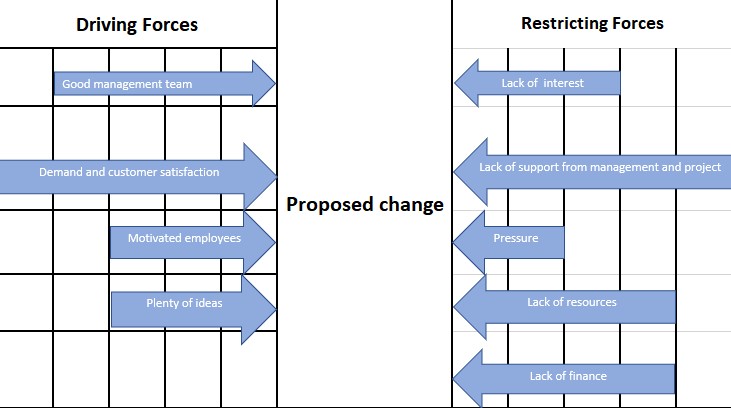Force field analysis is a tool that helps you to identify the forces help to accomplish the goals and those forces that hinders the attainment of the goals.
First developed by social psychologist Kurt Lewin in 1940s, force field analysis is now considered a highly effective tool to make decisions effective and structured so that both qualities of decisions and chances of any project success could be improved.
The force field analysis implies that for any change to happen the driving force must be strengthened or the weakening force must be reduced.
Step 1: Write the vision of your project or the main goal you want to attain in the middle.
Suppose: Goal= Improve the process
Step 2: Identify the internal and external drivers that can make the change.
- Internal drivers are those involved in the project itself. Such as equipment, management team, finance, and costs etc.
- External drivers are those that can be outside the scope of the project but yet can impact the project. For example, exchange rates, weather, and environment etc.
Use tools such as brainstorming, other root cause analysis tools, what-if analysis, stakeholder analysis, Voice of customers etc. to come to the decision that these forces are really causing the change. Also, include as many people associated with the project as possible so that a large number of ideas from different fields could be gathered.
These questions may help you to identify the drivers:
- What are the benefits of project?
- What are the inherent risks?
- Which business process could be improved?
- What are the core demands of the customers?
- Which demands should be addressed first?
Step 3: Identify the forces that resist the change
Using the same way as in Step 2, identify the internal and external factors that could resist changes.
Internal resistors-
- Fear
- Complex process
- Complex organizational structure
- Lack of resources
- Lack of finance
External resistors such as-
- Rules and regulations imposed by government
- Commitment to partners and customers
Step 4: Assign the score
Add a score according to the degree of influence (low numbers 1,2 signifying low influence and high numbers signifying more influence). You can do the same way visually by using the bigger arrow for bigger influence and smaller arrow for small influence.
Goal: Improve process
Force field diagram with a score
| Driving Force | Score (1-5) |
Proposed change |
Score (1-5) | Restraining Force |
| The good management team and a project champion | 4 | 3 | Lack of employee interest | |
| Demand and customer satisfaction | 5 | 5 | Lack of support from management and project part | |
| Motivated employees | 3 | 2 | Production pressure | |
| Plenty of ideas | 3 | 4 | Lack of resources | |
| 4 | Lack of finance |
Force Field Analysis diagram with arrow

Subscribe us for more on Force Field Analysis and other related free contents, lean six sigma and business improvement templates, free certification e-courses, ebooks and monthly newsletters by clicking here
